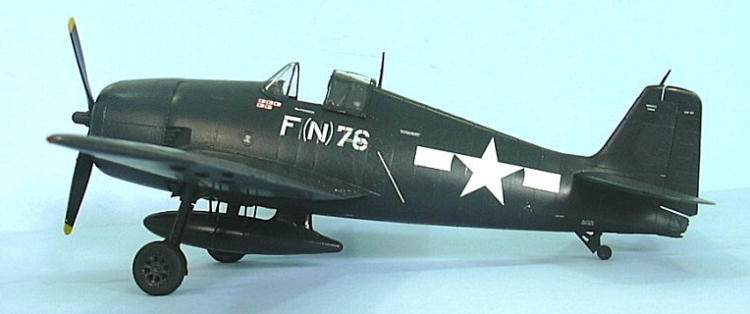
Eduard 1/48 F6F-5N Hellcat
| KIT #: | R0006 |
| PRICE: | $160.00 MSRP |
| DECALS: | Nine options |
| REVIEWER: | Tom Cleaver |
| NOTES: | Royal Class kit. Two aircraft with tons of aftermarket. |

| HISTORY |
The F6F‑3/5 Hellcat is the most successful naval fighter series ever built.
With pilots of moderate training levels, the airplane
could more than hold its own against its opponents, while it was tractable
enough that the same moderately‑trained pilot could bring a damaged one back and
get aboard his carrier, a point of no small importance in naval warfare.
It is the only fighter of the Second World War to remain
essentially unchanged in basic design from its introduction to service to its
post‑war withdrawal, with the main difference between the two production
variants being engine power.
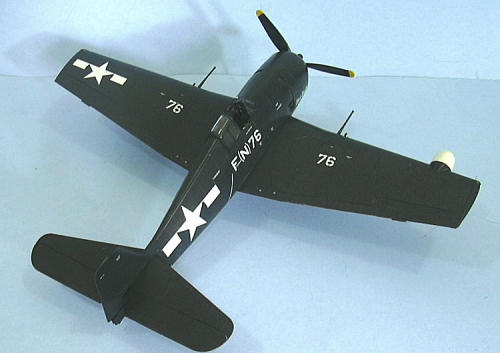 had
had
The Hellcat first entered combat in the fall of 1943, as
the
In 1943, the Navy began developing the Hellcat as a single-seat night fighter.
While the F4U Corsair was also used for this role, the
Hellcat was considered better for the role since its landing characteristics
were so much better than the Corsair, something of importance when it came to
landing aboard a heaving carrier deck at night.
In the end, the Marines made more use of the Hellcat as
a night fighter.
These squadrons were used with great effect during the Okinawa
campaign, where they brought Japanese night attacks to a virtual halt.
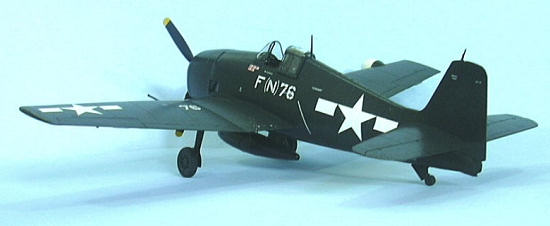
I had the opportunity of meeting Bruce on several occasions in the 1980s and early 1990s, when he was a guest at the Planes of Fame Air Museum.
| THE KIT |
Many modelers wondered why Eduard would do a Hellcat when two different good
models were already available.
After studying the various releases Eduard has done to
date of the Hellcat, I can say that they did it for the same reason they
released a series of Fw-190s in 1/48: their product is superior.
The kit has surface detail that is superior to either the Otaki or Hasegawa
kits, with very petite engraved rivet detail along panel lines, and separate
control surfaces that can be posed dynamically.
The kit has separate fuselages, wings and cowlings for
the F6F-3 and F6F-5, which take into consideration detail differences beyond the
obvious that other kit manufacturers have missed in their desire to cut costs,
as well as ordnance that is different to the two types as regards the F6F-3 and
F-6F-5.
The kits include nicely-detailed cockpits in plastic, accompanied by
very good pre-painted photo-etch detail that is up to Eduard's usual standards.
Additional photoetch is there for the engine ignition
detail, as well as more detail for the wheel wells.
Resin engin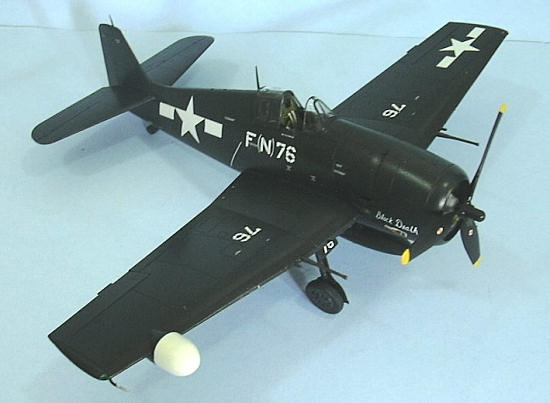 es
and corrected resin wheels, as well as separate resin parts for the night
fighter versions of both the F6F-3N and F6F-5N are provided.
Decals are provided for no less than
nine Hellcats: three F6F-3s, and six F6f-5s
including a French Aeronavale F6F-5, and two different Hellcat drones.
The best-known aces on the sheets are “Holly” Hills, the
RCAF/USN ace; night fighter ace Bruce Porter, and first Hellcat ace Hamilton
McWhorter, including his VF-9 F6F-3 and later VF-12 F6F-5.
The VU-1 Hellcat drone is in the later three colors,
while an early drone in overall orange is included.
es
and corrected resin wheels, as well as separate resin parts for the night
fighter versions of both the F6F-3N and F6F-5N are provided.
Decals are provided for no less than
nine Hellcats: three F6F-3s, and six F6f-5s
including a French Aeronavale F6F-5, and two different Hellcat drones.
The best-known aces on the sheets are “Holly” Hills, the
RCAF/USN ace; night fighter ace Bruce Porter, and first Hellcat ace Hamilton
McWhorter, including his VF-9 F6F-3 and later VF-12 F6F-5.
The VU-1 Hellcat drone is in the later three colors,
while an early drone in overall orange is included.
There has been the usual brew-ha-ha regarding the release of this kit among
those with too much time on their hands over at The Other Place, regarding the
accuracy of the kit in general and the “grin” in particular.
In his comprehensive review of the kit, Brett Green
points out that of the available Hellcat cowlings - both those from kits and
those from aftermarket producers - none is entirely accurate, though some are
moreso than others, concluding that the Eduard cowling is overall the most
accurate.
This is also the conclusion that has been drawn after copious
study of photo comparisons between actual Hellcats and the kit, from those
participating in the commentary Over There
Demonstrating that Eduard listens to valid criticism, the plastic wheels people
have complained about are accompanied by resin wheels no one should have any
problem with.
The resin engines are also beautifully cast.
There is an additional bag of resin parts for the night
fighters, including the radome and a wing gun replacement that includes the most
accurate representation of the 20mm cannons inboard I have seen in any kit.
I particularly like that the canopies are thin enough that they can be posed in the open position, since this is likely the best-detailed cockpit of any Hellcat kit, including the aftermarket resin cockpits that have been released over the years.
| CONSTRUCTION |
The Hellcat is basically a simple model to build overall, in any kit from any
manufacturer, and the Eduard kit is no exception.
One can do several small things to improve on what is
there, and the reader is referred to William Reece's article here at Modeling
Madness as an example of what is possible.
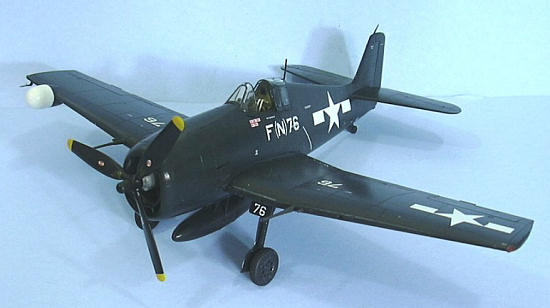 As designed, the separate control surfaces are not posable, though they do
provide separation of these surfaces from the main airframe.
Other than that, I cannot see why the kit was designed
this way, particularly since the Hellcat had a spring-loaded stick, so that the
controls were never “dynamically posed” while the airplane was on the ground to
begin with.
As designed, the separate control surfaces are not posable, though they do
provide separation of these surfaces from the main airframe.
Other than that, I cannot see why the kit was designed
this way, particularly since the Hellcat had a spring-loaded stick, so that the
controls were never “dynamically posed” while the airplane was on the ground to
begin with.
I
assembled the wings and tail surfaces and then attached them to the fuselage
halves before assembling the fuselage, because this allowed me to work the
connections from inside and out and get them fully seated, which I think is
necessary given the design for attaching the wings and tail.
Personally, I think Hasegawa got it right with a
one-piece lower wing that attached to the fuselage along panel lines, which
insured getting the proper dihedral to the wing.
The cockpit is perhaps the simplest Hellcat cockpit I have seen from any kit
since the Otaki release.
That said, with the use of the very complete photoetch,
what one sees in the end with the fuselage assembled and the cockpit closed up
is quite acceptable; much of the detail of the more-detailed Hasegawa kit
cockpit, or the True Details resin cockpit, isn't all that visible in the final
result.
I
needed to run some cyanoacrylate glue along the fuselage centerline seam, but
that was the only place the kit needed help.
The resin engines provided in the Royal Class kit are very nice, and with the
additional photoetch detail they make up into very accurate representations of
the R-2800, even providing the small differences between the engine used for the
F5F-3 and that used by the F5F-5.
I ended up with a time constraint if I was to finish
this in time for a review, and after looking at the first Hellcat I did and
seeing that the engine detail wasn't that apparent to a casual look once the kit
was finis hed,
I opted for the plastic engine.
However, this shouldn't be taken as any sort of vote of
no-confidence for the resin engine.
A modeler who wants a detailed engine will be very happy
with the final result if you proceed with this very nice sub-assembly.
hed,
I opted for the plastic engine.
However, this shouldn't be taken as any sort of vote of
no-confidence for the resin engine.
A modeler who wants a detailed engine will be very happy
with the final result if you proceed with this very nice sub-assembly.
The plastic engine assembles easily and looks right once it is inside the
cowling.
The cowling parts fit perfectly, and I only needed some cyanoacrylate
glue along the lower center seam to smooth that out.
I
attached the landing gear at this point since it would be painted the same
overall Dark Sea Blue as the rest of the model.
I
did modify the drop tank with some .010 x .015 Evergreen strip to create the
seam that was on all but the very late-production Hellcat drop tanks.
Overall, assembly of the model occupied an afternoon, including time spent
waiting for the paint to dry.
I pre-painted the cockpit parts interior green and the
cowling interior light grey, using Tamiya and Gunze-Sangyo acrylics.
I painted the engine cylinders Tamiya Flat Aluminum,
then hand-painted with Tamiya “Smoke” to pop out detail.
| COLORS & MARKINGS |
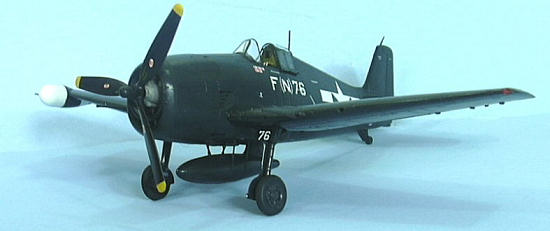 Painting:
Painting:
The model is the essence of easy for painting.
I painted the radome white, then masked it off, then
painted the rest of the model entirely in Xtracrylix Dark Sea Blue Gloss.
I have decided I really like the masks Eduard provides
for the canopies, since they cut down the time spent masking off the canopy with
Scotch tape and trimming with a knife.
Decals:
The kit decals went on without a problem. They are thick enough and opaque enough that none of the dark blue color bleeds through the white markings.
| FINAL CONSTRUCTION |
I
gave the model an overall coat of Xtracrylix Satin varnish.
When that was dry, I unmasked the canopy and posed it
open, and attached the main wheels and propeller.
| CONCLUSIONS |
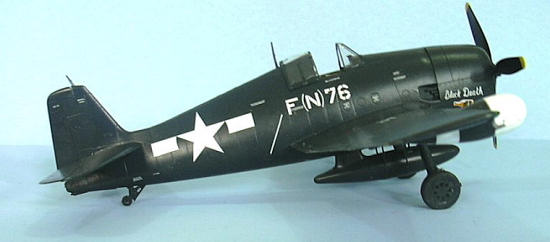 The Eduard Hellcat series is overall the most accurate kit of this airplane
available in 1/48 scale.
Surface detail is more accurate than any other kit, and
the detail differences between the F6F-3 and F6F-5 are fully covered in the
different kits.
Even doing a highly-detailed kit using all the extra items
provided in the Royal Class kit is not difficult and a modeler of average
abilities and produce a very good-looking model from these kits with a modicum
of effort.
The Eduard Hellcat series is overall the most accurate kit of this airplane
available in 1/48 scale.
Surface detail is more accurate than any other kit, and
the detail differences between the F6F-3 and F6F-5 are fully covered in the
different kits.
Even doing a highly-detailed kit using all the extra items
provided in the Royal Class kit is not difficult and a modeler of average
abilities and produce a very good-looking model from these kits with a modicum
of effort.
Thanks to Eduard for the review kit.
November 2008
Copyright ModelingMadness.com. All rights reserved. No reproduction in part or in whole without express permission.
If you would like your product reviewed fairly and quickly, please contact the editor or see other details in the Note to Contributors.